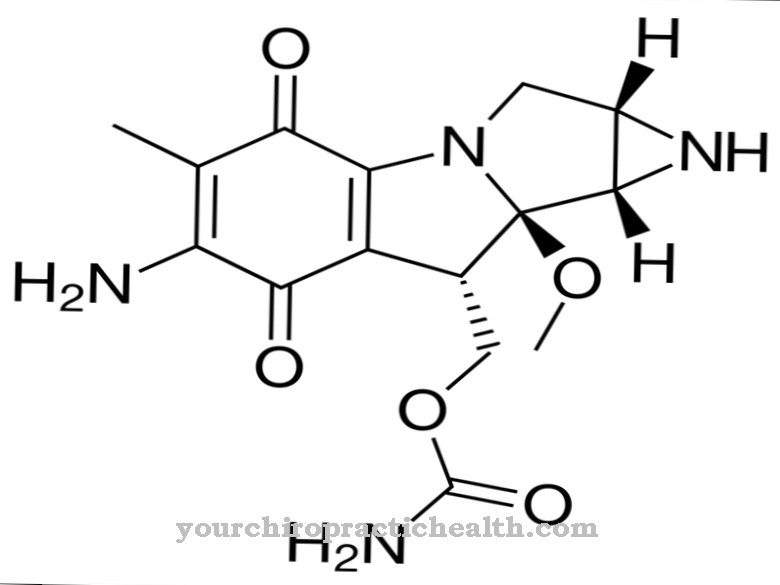Mitomycin C, often just as Mitomycin called, is used as a cytotoxic antibiotic. It belongs to the group of mitomycins and is the only approved chemotherapeutic agent of this group.
What is Mitomycin C?
The antibiotic mitomycin was isolated from Streptomyces caespitosus in 1958 and is effective against some viruses and gram-positive bacteria. It is now only used as a cytostatic agent in the treatment of various carcinomas and in the prevention of bladder cancer.
Mitomycin C is administered intravenously or intravesically (into the bladder). The active ingredient inhibits the growth or division of tumor cells.
Mitomycin is a blue-violet, crystalline powder that is used to make a solution for injection or infusion. It is available in Germany in the form of monopreparations under the trade names Amétycine®, Mitem®, Mito-medac® or Urocin®. Various generic Mitomycin drugs are also available in Germany and Austria.
Pharmacological effect on the body and organs
Mitomycin C belongs to both the antibiotics and the cytostatics group. After being metabolized, the active ingredient has a cell-killing effect. This is where the actual active substance is created.After enzymatic activation, DNA synthesis is inhibited, with mitocymin becoming embedded between two DNA strands. As a result, they are firmly connected to one another, and the DNA strands can no longer be separated. This process prevents tumor cells from multiplying.
It is administered intravenously. A high concentration of mitomycin C can then be found in the heart, kidneys, lungs, muscles, gall bladder, tongue and urine. However, the substance is rapidly inactivated by enzymes in the liver, spleen, heart and kidneys.
Mitomycin is primarily excreted via the kidneys. When using mitomycin in intravesical chemotherapy, the effectiveness can be optimized by urinalization.
Medical application & use for treatment & prevention
Mitomycin C can be used in many different ways in the treatment of cancer. It is used, among other things, in the treatment of bladder cancer, breast cancer, cancer of the colon and rectum, liver cell cancer, cervical cancer, esophageal cancer, head and neck cancer, pancreatic cancer, stomach cancer, bronchial cancer or also in osteosarcoma (malignant bone tumors) and blood cancer (leukemia) . Mitomycin C is also used in hyperthermal intraperitoneal chemotherapy (HIPEC, treatment for tumor involvement of the peritoneum).
Mitomycin must not be used if you are hypersensitive to the active ingredient, if you have a tendency to bleed, if the bone marrow is impaired, if you are in poor general condition, if you have an inflammation of the bladder (if it is to be used in the bladder) and if the kidneys, lungs and liver are damaged.
Therapy must be discontinued immediately if lung complaints develop that are not related to the underlying disease. Treatment must also be stopped in the case of anemia and impaired kidney function.
Women of sexually mature age should take measures to prevent pregnancy during and for up to 6 months after treatment with mitomycin C. Due to the proven development of deformities in the unborn child, mitomycin must also not be used during pregnancy and breastfeeding.
You can find your medication here
➔ Medicines for relaxation and nerve strengtheningRisks & side effects
The administration of mitomycin C can also cause side effects. These can, but do not have to, occur. Everyone reacts differently to medication, which is why the possible side effects can be differentiated according to the type of frequency.
The very common side effects with mitomycin C use include nausea and vomiting, and bone marrow malfunction associated with a lack of platelets and white blood cells.
Common side effects are cough, shortness of breath, shortness of breath, pneumonia, local or allergic rash, reddening of the palms of the hands and feet, contact dermatitis, an increase in creatinine in the blood, a dysfunction of the kidneys or a disease of the filter cells in the kidney.
When mitomycin is used in the bladder, cystitis, problems urinating, very frequent urination, the need to urinate at night, and local irritation of the bladder wall can be side effects. Injection into tissue can also cause inflammation of the cells or tissue death.
Hair loss, inflammation of the mucous membranes and the oral mucosa, fever or even diarrhea are occasional side effects of mitomycin.
The rare to very rare side effects include increased enzyme levels in the blood, liver dysfunction, loss of appetite, jaundice, anemia, blood poisoning, pulmonary hypertension, heart muscle weakness, severe allergic reactions or even the death of bladder tissue when used in the bladder.
If other drugs or substances are taken at the same time, the effects of mitomycin can change. If substances that damage the bone marrow are taken at the same time, the negative effects complement each other. If mitomycin is taken in combination with vinca cytostatics (e.g. vincristine) or the antibiotic bleomycin, the harmful effects of mitomycin on the lungs increase.
Vaccination with live vaccines should not be given due to the weakened immune system while taking mitomycin C, otherwise infections can occur. Mitomycin can also make adriamycin more harmful to the heart.
Mityomycin C may only be administered by doctors with experience in cancer therapy. The injection is only intended into the blood vessels, it must not get into the surrounding tissue. If nausea and vomiting occurs due to the use of mitomycin, it may change the ability to react. Driving a car or operating machines then becomes a danger.
Reactivity is limited even if alcohol is consumed at the same time. Should patients experience side effects that are not listed here, the attending physician must be consulted immediately.













.jpg)

.jpg)
.jpg)











.jpg)